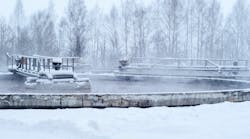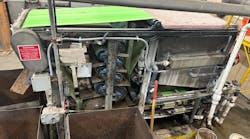The Melbourne Water Corporation in Australia had a serious
wastewater treatment odor problem which was solved through the design and
construction of the world’s largest floating membrane cover system, built
by Geomembrane Technologies Inc. (GTI) of Fredericton, New Brunswick, Canada.
With a serviced population of 2.3 million people, the
Melbourne Water Corporation’s Western Treatment Plant has been in service
since 1897, covers an area of 27,000 acres, and combines lagoon and land
treatment to process an average flow of 124 million gallons of sewage daily — 52 percent of Melbourne’s sewage.
The anaerobic treatment process generates biogas that was
the subject of odor complaints and greenhouse gas concerns. Biogas contains
mostly methane, with smaller amounts of carbon dioxide, nitrogen, hydrogen
sulphide and water vapor. A cover system was required to capture biogas and
send it through a pipeline for odor treatment and future utilization as a fuel.
Melbourne Water wanted a cover design that could be installed
without taking the lagoons out of service. They also wanted a system that was
low maintenance and could facilitate maintenance activities, when required. The
covers had to be self-draining, have structural integrity to withstand
pressures caused by scum development, and facilitate biogas migration /
collection. All of these requests were met by the designers and fabricators.
The project included an ISO 9001- compliant quality
assurance plan and an environmental management plan. The cover design and pre-fabrication was completed in North America, with the individual cover sections then shipped to Australia for installation. Geomembrane Technologies Inc. also provided training of operators and maintenance personnel, performance testing, and
aftercare assistance.
The project involved covering the inlet ends of two lagoons
(25 West and 55 East) using a three-layer floating insulated cover made of a
high performance reinforced geomembrane (Seaman XR5), a middle layer of
polyfoam insulation, and a bottom layer of high density polyethylene. The
underskin provides protection of the cover system from scum development and
scum movement under the cover. The XR5 material provides minimal expansion /
contraction due to changes in ambient temperature, is ultra-violet light
resistant, and has high tensile strength. The three-layer nature of the cover
system, with top layer floating free and bottom layer welded to the foam
insulation, provides a lightweight but durable structural integrity to the
cover system which allows buoyancy and access for maintenance and inspection.
The action of accumulated rainwater and wind can play havoc
on the longevity of cover systems and the degree of maintenance required. The
cover installed for Melbourne Water incorporates a network of weights, floats
and self-regulating gravity drains that allow passage of rainwater into the
liquid below. There are no folds in the design for collection of rainwater, and
since there are no folds, there are fewer wear areas in the cover that require
periodic maintenance.
The foldless cover design allows the designer to use the
entire walled perimeter of the lagoon as a transmission zone for biogas since
the cover sweeps from the top of the wall, where there is a gas-tight seal,
down to the liquid surface. The sweep area, along with a system of floats and
weights, allows unhindered conveyance of biogas from the central areas of the
cover to the perimeter where it is conveyed through wall penetrations and
piping to the biogas blowers. (GTI’s cover systems are protected by
patents and patents pending.)
The covers dimensions are 650 ft. by 560 ft. for 25 West
lagoon and 700 ft. by 650 ft. for 55 East lagoon. Biogas is captured under the
covers and conveyed for either treatment in a flare or utilization as a fuel
for electrical generation. Construction of an electrical generation system is
currently underway (by others). The covers are specially designed to store
biogas in low electrical demand periods so that it can be used in periods of
greater demand when electricity sells for a higher price.
Biogas flows from each of the lagoons is expected to be
between 195,000 f3 / d and 635,000 f3/d. It is expected that electricity will
be generated between 8 and 16 hours per day, only during peak demand period.
Given an average biogas production of 1,342,000 f3 /d at a methane content of
65 percent, the expected generator set sizing is 6000 kW. With an average electricity cost of
$0.07/kWh, the value of the biogas is estimated to be $1.8 million annually.
The biogas collection and treatment system is controlled by
an Allen Bradley PLC5 in communication with ADI’s APM windows based
control software using a PC operator interface. The system can be monitored
remotely, and changes to the software can be made through the Internet.
The floating cover system at Melbourne Water’s Western
Treatment Plant has been in operation for over three years now and continues to
operate successfully.

